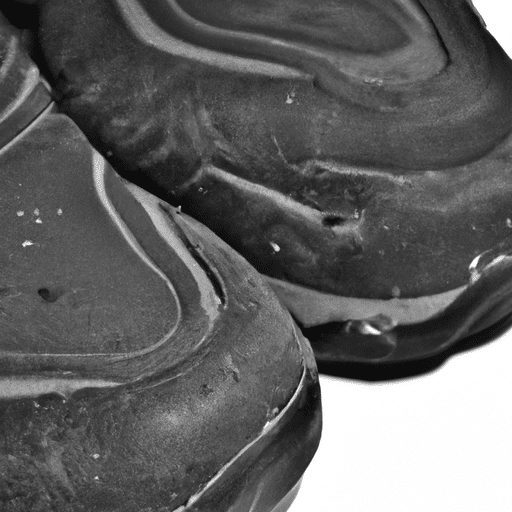Looking to embark on a long-distance walk but unsure of what footwear to choose? In this article, we explore the suitability of walking shoes for those extended treks. Many of us may already own a trusty pair of walking shoes, but are they truly up to the task of enduring the demands of a long-distance journey? Join us as we delve into the fascinating world of walking shoes and discover whether they are the right match to keep our feet happy during those lengthy hikes. Walking shoes are not only suitable but also essential for long-distance walks. Improper footwear can have detrimental effects on your experience and even lead to foot problems and injuries. The right walking shoes provide necessary support, cushioning, stability, and comfort, allowing you to enjoy your long walks without any discomfort or pain.
The effects of improper footwear on long-distance walks
When it comes to long-distance walks, wearing improper footwear can have serious consequences. Without the right support and cushioning, you are more likely to experience foot fatigue, blisters, calluses, and even long-term foot issues. Additionally, inadequate shoes can affect your gait and stability, increasing the risk of ankle sprains and other injuries. Therefore, it is crucial to invest in proper walking shoes that are specifically designed for long-distance walks.
How walking shoes can provide necessary support
Walking shoes are designed to provide the necessary support your feet need during long walks. They have specific features that offer stability, cushioning, and shock absorption, which help to reduce the impact on your feet and joints. The midsole of walking shoes is often made of a supportive material such as EVA or polyurethane foam, which helps to maintain proper foot alignment and prevents overpronation or supination. The outsole of walking shoes also provides excellent traction, ensuring stability on various terrains.
Key features of walking shoes for long-distance walks
There are several key features to look for when choosing walking shoes for long-distance walks. These features ensure that your feet are properly supported and protected during your walks. First, consider the level of arch support provided by the shoes. Different individuals have different arch types, so it is important to find shoes that offer the right level of support for your specific needs. Cushioning and shock absorption are also crucial, as they help to absorb impact and reduce the strain on your feet and joints. Breathability and moisture-wicking properties are essential for long walks, as they help to keep your feet dry and prevent the development of blisters. Additionally, walking shoes should offer a good balance of flexibility and stability, allowing your feet to move naturally while still providing support. Lastly, the weight and durability of the shoes should be taken into consideration, as heavy shoes can add unnecessary strain on your feet, and durability ensures that your shoes will last for the duration of your long-distance walks.
The benefits of wearing walking shoes
Wearing walking shoes for long-distance walks offers numerous benefits. Firstly, they provide the necessary support and cushioning to prevent foot fatigue and injuries. With the right shoes, you can enjoy your walk without worrying about discomfort or pain. Walking shoes also help to distribute pressure evenly across your feet, reducing the risk of developing blisters, calluses, or other foot issues. Additionally, the stability and traction provided by walking shoes give you confidence and prevent accidents on uneven or slippery surfaces. By wearing appropriate walking shoes, you can focus on enjoying the scenery and the experience of your long-distance walks, rather than dealing with foot problems.
Foot type and pronation
When choosing walking shoes for long-distance walks, it is essential to consider your foot type and pronation. There are three main types of foot arches: low arches (flat feet), medium arches, and high arches. Each foot type requires different levels of support. If you have low arches, you will need shoes with excellent arch support to prevent overpronation. If you have high arches, look for shoes that offer cushioning and shock absorption, as well as a curved last to accommodate the shape of your foot. Medium arches usually require a balance of support and cushioning. Determining your foot type and pronation can help you find walking shoes that cater to your specific needs and prevent any potential foot issues.
Arch support
Arch support is a crucial factor to consider when choosing walking shoes. The arch of your foot acts as a natural shock absorber, and proper support helps maintain proper alignment and prevent overpronation or supination. Overpronation occurs when the arch of the foot collapses too much, causing excessive inward rolling of the foot. On the other hand, supination occurs when the foot rolls outward, putting extra stress on the outer edge of the foot. Walking shoes with built-in arch support help to correct these issues and provide stability and balance during long walks.
Cushioning and shock absorption
Long-distance walks can be strenuous on your feet and joints. That’s why cushioning and shock absorption are crucial features to look for in walking shoes. The midsole of the shoes should be made of a material that provides adequate cushioning to absorb the impact of each step and reduce the strain on your feet and joints. Materials such as EVA foam or polyurethane are commonly used in walking shoes for their excellent shock absorption properties. Proper cushioning not only enhances comfort but also prevents injuries and reduces foot fatigue, allowing you to walk longer distances with ease.
Breathability and moisture-wicking
During long-distance walks, your feet are bound to sweat, and moisture can lead to discomfort and even foot problems such as blisters. Therefore, it is crucial to choose walking shoes that offer breathability and moisture-wicking properties. Look for shoes made with breathable materials, such as mesh uppers, which allow air to circulate around your feet and keep them dry. Additionally, moisture-wicking lining or insoles can help to absorb and evaporate sweat, further preventing the development of blisters or fungal infections.
Flexibility and stability
When walking long distances, you want your shoes to provide the perfect balance of flexibility and stability. Flexible shoes allow your feet to move naturally, promoting a more efficient gait and reducing the risk of strain or injury. However, the shoes should also provide sufficient stability to support your feet and prevent excessive pronation or supination. Look for walking shoes with a good balance between flexibility and stability, ensuring that your feet are protected while allowing for a comfortable and natural walking motion.
Weight and durability
The weight and durability of walking shoes are important factors to consider for long-distance walks. Heavy shoes can increase fatigue and put unnecessary strain on your feet and legs, limiting your ability to walk long distances comfortably. Lightweight walking shoes allow for a more effortless stride and less fatigue, enabling you to enjoy your walks for longer periods. Additionally, the durability of the shoes is crucial, as you need footwear that can withstand the demands of long-distance walks. Look for shoes made with durable materials and reinforced areas, such as the toe box and sole, to ensure longevity.
Proper fit and sizing
Perhaps the most important factor when choosing walking shoes is finding the right fit and sizing. Ill-fitting shoes can lead to a host of foot problems, such as blisters, calluses, and even more severe issues like bunions or plantar fasciitis. When selecting walking shoes, take the time to measure your feet and try on different sizes and widths to find the perfect fit. Consider factors such as toe room, heel grip, and overall comfort. Keep in mind that your feet may swell during long walks, so it’s advisable to choose shoes that allow for some extra room without being too loose.
Studies on the benefits of walking shoes
Numerous studies have been conducted to assess the benefits of walking shoes for long-distance walks. These studies have consistently found that wearing appropriate walking shoes can significantly reduce the risk of foot problems, injuries, and fatigue. A study published in the Journal of Orthopaedic & Sports Physical Therapy found that individuals who wore walking shoes experienced less foot pain and had better overall foot function during prolonged walking compared to those who wore running shoes or casual shoes. Another study published in the British Journal of Sports Medicine concluded that proper walking shoes reduced the risk of lower limb injuries in long-distance walkers. These studies provide scientific evidence supporting the use of walking shoes for long-distance walks.
Opinions of podiatrists and orthopedic specialists
Podiatrists and orthopedic specialists are experts in foot and ankle health, and their opinions on walking shoes for long-distance walks hold great value. Many professionals in the field emphasize the importance of wearing appropriate footwear to prevent foot problems and injuries. They recommend walking shoes for their supportive features, cushioning, and stability, which help to alleviate stress on the feet and minimize the risk of developing long-term foot issues. Podiatrists can also provide valuable insights into an individual’s specific foot concerns and help recommend the most suitable walking shoes for their needs.
Insights from experienced long-distance walkers
Experienced long-distance walkers can provide valuable insights into the benefits of walking shoes. Their real-life experiences offer practical information and recommendations to individuals embarking on long-distance walks. Many seasoned walkers emphasize the importance of finding the right walking shoes to ensure comfort and prevent foot problems. They highlight the significance of features such as arch support, cushioning, and proper fit in enabling them to complete long walks without discomfort or pain. Hearing from those who have successfully completed long-distance walks can provide valuable guidance and inspire confidence in the use of walking shoes.
Trail running shoes
Trail running shoes are a popular alternative to traditional walking shoes for long-distance walks. They are designed to provide stability and support on various terrains and offer features similar to walking shoes, such as cushioning and flexibility. Trail running shoes often have a more aggressive outsole tread pattern, which provides excellent traction on uneven or slippery surfaces. Many long-distance walkers prefer trail running shoes for their versatility and ability to adapt to different walking conditions.
Hiking boots
Hiking boots are another alternative to walking shoes for long-distance walks, especially if you plan to walk on rough terrain or encounter challenging weather conditions. Hiking boots offer enhanced ankle support, protection, and stability, which are beneficial for off-road walking. They typically feature a more rigid midsole and sturdy construction to withstand harsh environments. However, hiking boots tend to be heavier and less flexible than walking shoes, which may affect comfort over long distances.
Minimalist or barefoot shoes
Minimalist or barefoot shoes have gained popularity in recent years for their lightweight and flexible design. These shoes aim to mimic the feeling of walking barefoot while still providing some protection and support. They have a minimal or zero-drop heel-to-toe offset and often feature a wide toe box to allow for natural foot movements. Some long-distance walkers prefer minimalist or barefoot shoes for their natural and unrestricted feel. However, it is important to note that transitioning to minimalist shoes requires careful adjustment and strengthening of the feet and lower legs, as they provide less cushioning and support compared to traditional walking shoes.
Sandals and flip-flops
Sandals and flip-flops are not typically recommended for long-distance walks, as they lack the necessary support and cushioning for extended periods of walking. These types of footwear offer minimal protection and often lead to foot fatigue, blisters, and instability. While sandals may be suitable for short walks in warm weather, they are not ideal for the demands of long-distance walking. It is advisable to choose more supportive and protective footwear options, such as walking shoes or trail running shoes, for optimal comfort and foot health.
Advantages of walking shoes
Walking shoes offer several advantages for long-distance walks. Firstly, they provide the necessary support and cushioning to prevent foot fatigue and injuries. The arch support and cushioning in walking shoes help distribute pressure evenly across your feet, reducing the risk of blisters, calluses, and foot pain. Walking shoes also offer stability and traction, ensuring balance and reducing the risk of slips or falls. Additionally, walking shoes are designed specifically for walking, considering the mechanics of the gait and the impact of each step. This specialized design enhances efficiency and comfort during long-distance walks.
Disadvantages of walking shoes
While walking shoes have numerous benefits, they may have a few disadvantages as well. One potential disadvantage is the initial cost of quality walking shoes, as they can be more expensive than casual shoes. However, the investment in well-fitting and supportive walking shoes pays off in terms of comfort, durability, and foot health in the long run. Another potential disadvantage is the weight of some walking shoes, particularly those designed for added stability or durability. Heavier shoes may contribute to fatigue, especially during extended walks. However, many walking shoe manufacturers offer lightweight options that prioritize both support and reduced weight.
Consulting a professional for proper fitting
To ensure that you select the right walking shoes for your long-distance walks, it is highly recommended to consult a professional shoe fitter. They can accurately measure your feet and provide guidance on finding the most suitable size, width, and fit for your specific needs. A professional shoe fitting ensures that you choose walking shoes that accommodate any foot abnormalities or concerns, preventing discomfort and potential foot problems.
Trying on shoes in the late afternoon
When trying on walking shoes, it is best to do so in the late afternoon or evening. Feet tend to swell throughout the day, especially during activities like walking. By trying on shoes later in the day, you can ensure a more accurate fit that accommodates any swelling that may occur during your walks.
Considering insoles or orthotics
In some cases, individuals may require additional support beyond what standard walking shoes provide. Custom insoles or orthotics can help address specific foot concerns or irregularities. These inserts can provide targeted support, cushioning, and stability, enhancing the overall fit and comfort of your walking shoes. Consulting with a podiatrist or a shoe fitting specialist can help determine if insoles or orthotics are necessary for your long-distance walks.
Breaking in the shoes gradually
To avoid discomfort or blisters during long-distance walks, it is essential to break in your walking shoes gradually. Start by wearing them for short walks or around the house to allow your feet to adjust to the new shoes. Gradually increase the duration and intensity of your walks while wearing the shoes until they feel comfortable and supportive. By properly breaking in your shoes, you can minimize the risk of developing blisters or sore spots during your long-distance walks.
Understanding when to replace worn-out shoes
Walking shoes, like any footwear, have a limited lifespan. It is important to know when to replace worn-out shoes to maintain optimal comfort and support during long-distance walks. As a general guideline, walking shoes should be replaced every 300 to 500 miles or when they show visible signs of wear and tear, such as a worn-down outsole or a loss of cushioning. Continuing to wear shoes that are past their prime can lead to foot discomfort, decreased support, and an increased risk of injuries.
Proper care and maintenance of walking shoes
To prolong the life of your walking shoes and ensure they continue to provide the necessary support, it is important to practice proper care and maintenance. After each walk, remove any dirt or debris from the shoes and allow them to dry naturally. Avoid exposing them to excessive heat, as it can damage the materials. If the shoes become excessively dirty, gently clean them using mild soap and water. Regularly inspect the shoes for signs of wear or damage, such as loose stitching or worn-out soles. Taking care of your walking shoes will ensure their durability and continued performance throughout your long-distance walks.
Testimonials from long-distance hikers
Real-life experiences from long-distance hikers can provide valuable insights into the performance and benefits of walking shoes. Testimonials often highlight the level of comfort, support, and durability that walking shoes offer during extended periods of walking. Many long-distance hikers recommend specific brands and models that have served them well on their journeys. Reading about the positive experiences of others can help inform your decision and inspire confidence in choosing walking shoes for your long-distance walks.
Stories from marathon walkers
Marathon walkers, who regularly undertake long-distance walks, can also provide valuable stories and experiences related to walking shoes. These individuals often walk distances of 26.2 miles or more, putting their footwear to the ultimate test. Their firsthand accounts can shed light on the importance of proper footwear and how walking shoes have positively impacted their performance, comfort, and overall enjoyment during these endurance walks. By listening to their stories, you can better understand the benefits of walking shoes for long distances.
Lessons learned from seasoned walkers
Seasoned walkers, who have many years of experience in long-distance walks, have invaluable lessons to share. These individuals have encountered various challenges and have refined their approach to footwear selection over time. Their insights can help you avoid common pitfalls, choose the right walking shoes, and maintain foot health during your long-distance walks. Whether it’s tips on proper fit, choosing the right features, or techniques for preventing foot issues, seasoned walkers can provide practical knowledge based on their years of walking experience.
Walking barefoot is better for long-distance walks
One common misconception about long-distance walks is that walking barefoot is better than wearing walking shoes. While going barefoot may suit some individuals, especially those with strong, well-conditioned feet, it is not the best choice for everyone. Walking barefoot lacks the support, cushioning, and protection that walking shoes provide. Long-distance walking can put significant strain on your feet, and wearing appropriate walking shoes helps reduce stress, prevent injury, and maintain optimal foot health. Therefore, it is generally advisable to opt for walking shoes over going barefoot for long-distance walks.
Walking shoes are unnecessary if you have strong feet
Another misconception is that walking shoes are unnecessary if you have strong, well-conditioned feet. While having strong feet certainly helps, it does not eliminate the need for proper support, cushioning, and stability that walking shoes provide. Even individuals with strong feet can still benefit from the enhanced shock absorption, balance, and protection offered by walking shoes during long-distance walks. Strong feet alone may not be sufficient to prevent foot fatigue, blisters, or strain on the joints. Walking shoes are designed to cater to the specific demands of walking, ensuring optimal comfort and foot health during extended walks.
All walking shoes are the same
Some may falsely believe that all walking shoes are the same and that any pair will suffice for long-distance walks. However, this is far from the truth. Walking shoes come in various styles, with different features, levels of support, and cushioning. Each individual has unique foot characteristics and requirements. Therefore, finding the right walking shoes for long-distance walks involves considering factors such as foot type, arch support, cushioning, flexibility, and stability. Selecting the right walking shoes tailored to your specific needs is essential for optimal comfort and protection during long-distance walks.
Walking shoes cannot prevent foot problems
While walking shoes cannot guarantee complete prevention of foot problems, they can significantly reduce the risk of developing them. Walking shoes offer the necessary support, cushioning, and stability to minimize strain on the feet and reduce the impact of walking on your joints. By choosing properly fitting walking shoes with the right features, you can greatly decrease your chances of developing foot issues such as blisters, calluses, or plantar fasciitis. Additionally, walking shoes can help maintain proper foot alignment and prevent overpronation or supination, reducing the likelihood of developing long-term foot problems.
Gradually increasing walking distances
For walkers transitioning to long-distance walks, gradually increasing your walking distances is essential. This gradual approach allows your feet and muscles to adapt to the increased demands and helps prevent overuse injuries. Start with shorter distances and gradually increase the duration or distance of your walks over time. By gradually building up your walking distance, you give your feet and body the opportunity to adjust and strengthen, reducing the risk of discomfort or injury during long-distance walks.
Building strength and endurance through training
In preparation for long-distance walks, it is important to build strength and endurance through training. Strengthening exercises, such as foot and calf exercises, can help condition the muscles and tendons in your feet and lower legs, enhancing stability and supporting improved walking mechanics. Additionally, endurance training, such as gradually increasing the duration of your daily walks or incorporating longer walks into your routine, can prepare your body for the rigors of long-distance walks. This combination of strength and endurance training helps reduce the risk of fatigue and allows you to enjoy your long walks with greater ease.
Monitoring and addressing any developing foot issues
During training or long-distance walks, it is crucial to monitor your feet for any developing foot issues. Pay attention to any discomfort, pain, or signs of irritation, such as redness or hot spots. If you notice any problems, it is important to address them promptly to prevent them from worsening. This may include adjusting your shoes, adding additional cushioning or support, or seeking advice from a healthcare professional. By actively monitoring and addressing foot issues, you can prevent them from becoming more severe or compromising your ability to continue with your long-distance walks.
Finding the right walking shoes for individual needs
Every individual has unique foot characteristics and specific needs when it comes to walking shoes. It is crucial to find the right walking shoes that cater to your specific requirements. This may involve considering factors such as foot type, arch support, cushioning, flexibility, and stability. Seeking the assistance of a professional shoe fitter, podiatrist, or orthopedic specialist can provide additional guidance in finding the perfect walking shoes for your long-distance walks. The right shoes will enhance your walking experience and help you achieve your walking goals comfortably and safely.
Conclusion
In conclusion, walking shoes are highly suitable and essential for long-distance walks. They provide the necessary support, cushioning, stability, and comfort to ensure an enjoyable and pain-free walking experience. When selecting walking shoes, factors such as foot type, arch support, cushioning, breathability, flexibility, and proper fit should be considered. Numerous studies, expert opinions, and real-life experiences from long-distance walkers support the use of walking shoes for optimal foot health and overall walking performance. By choosing the right walking shoes and incorporating proper care and maintenance, you can embark on your long-distance walks with confidence, knowing that your feet are well-supported and protected.







































